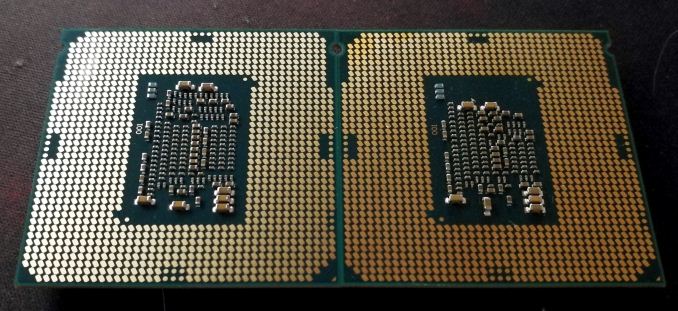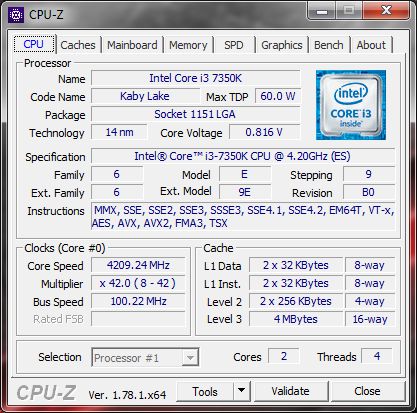The Intel Core i3-7350K (60W) Review: Almost a Core i7-2600K
by Ian Cutress on February 3, 2017 8:00 AM ESTCasual Enthusiasts Rejoice
No matter your taste for being labeled, the PC and gaming market is awash with different segments that loosely collate different requirements. Some want high-performance at any cost, others are power conscious, and some want the best gaming performance for their budget. For this latter group, the Core i3-7350K is a serious contender to throw some money at.
In our single GPU tests (which are admittedly showing their age a small bit), at 1080p and 4K, the Core i3-7350K was on par with the Core i5-7600K and Core i7-7700K. The Core i3 part is not seriously marketed at SLI/CFX configurations, so maintaining a good level performance at mainstream resolutions using a single graphics card is important in this performance for a 'budget' build. The high single core frequency at 4.2 GHz, or more when overclocked, ensures that the Core i3 hits a high level of performance in most DX11 gaming where performance can differ. Out of our gaming tests, the Core i5-7600K offered a small gain with mid-range GPUs on Grand Theft Auto, but for the most part performance was on par or within a few percent.

Core i7-7600K (left) and Core i3-7350K (right)
For underlying performance, the Core i3-7350K is one of the fastest single threaded performers on the market. The combination of 4.2 GHz and Kaby Lake IPC means that only the i7-7700K is the only one that beats it. For basic programming and web work, having one of the fastest chips on the market may help improve the experience. However, starting to add more complex work in to the mix shows that the dual core chip can be a bottleneck – any workload with heavy threads, such as compute (compression, rendering, matrix compute), is going to hand a performance advantage to a Core i5. A good example of this is Agisoft: the Core i5-7400 (which costs $14 more, quad core, 3.0-3.5 GHz) completes the work ~10% quicker.
For overclocking, the Core i3-7350K matches the other Kaby Lake overclocking parts. Our retail stepping sample achieved 4.8 GHz without any AVX offset, similar to our Core i5-7600K and Core i7-7700K. One of the upsides of the overclock was the power consumption: due to the 1.2 volts applied to the CPU at stock frequencies, our overclock only produced another +12W in power consumption. It was perhaps surprising that the Core i5-7400 had a much lower power consumption than the dual core, but the high base frequency leads to a higher stock voltage which translates to power consumption.
What would be interesting to see is how the power consumption changes with some of the lower clocked Core i3 parts. From our overclocking/underclocking results, a 4.0 GHz Core i3 at 1.100 volts would only consume 43W.
Ultimately, the state of the Core i3-7350K depends on what you are interested in as an enthusiast.
- Overclocking? It’s a fun choice.
- Responsiveness? Top class.
- Mainstream 1080p Gaming? A cheaper equivalent to the Core i5.
- Power? A lower clocked i3 is better on efficiency.
- Heavy workloads? Spend $14 and go for a Core i5.
The idea internally (inside my head) is to rerun this set of interesting Intel CPUs on Windows 10 with newer DX12 games and newer GPUs over the next few months. It’s going to be fun. I think.
More about Kaby Lake
For readers that want a more in-depth take on Kaby Lake as a platform, we have a dedicated article full of information for you. We also have other articles in our Kaby Lake bonanza.
Other articles include:
Intel Launches 7th Generation Kaby Lake (Overview and Core Improvements)
The Intel Core i7-7700K Review: The New Out-of-the-box Performance Champion
The Intel Core i5-7600K Review: The More Amenable Mainstream Performer
The Intel Core i3-7350K Review: When a Core i3 Nearly Matches the Core i7-2600K (This Review)
Still to come
Calculating Generational IPC Changes from Sandy Bridge to Kaby Lake
Intel Core i7-7700K, i5-7600K and i3-7350K Overclocking: Hitting 5.0 GHz on AIR
Intel Launches 200-Series Chipset Breakdown: Z270, H270, B250, Q250, C232
Intel Z270 Motherboard Preview: A Quick Look at 80+ Motherboards











186 Comments
View All Comments
cknobman - Friday, February 3, 2017 - link
I definitely think they should have at least included those results.fanofanand - Friday, February 3, 2017 - link
Some people purchase a "K" processor for the binning, not to overclock it.JackNSally - Friday, February 3, 2017 - link
Ok. So exclude those that buy it to overclock?fanofanand - Sunday, February 5, 2017 - link
I was responding to the comment saying the only reason to get a k was to overclock.WithoutWeakness - Friday, February 3, 2017 - link
Absolutely should have included overclocking. Sandy Bridge chips had very conservative stock clocks and great overclocking potential. At the time you were almost guaranteed 4.4GHz-4.7GHz on air and and there were lucky users reaching 4.8-5GHz (and more under water). My 2600K has been running stable at 4.6GHz (a 35% overclock) for six years now at 1.35v. Those single-threaded charts would look much different if you included overclocks and the multi-threaded charts would seriously widen the gap.I'm glad Intel has opened the gates for overclocking i3's but this review really just shows how small Intel's gains have been in the last six years. I'm hoping Ryzen brings some serious performance to the table (especially at the high end) and lights a fire under Intel's asses. Better iGPUs and lower power consumption are great for laptops and and basic users's needs but there has been no innovation in the HEDT market for many years unless you're willing to shell out $1700 for the 10-core Extreme Edition.
CaedenV - Friday, February 3, 2017 - link
Yep! Sandy Bridge was/is good tech!I got the non-K i7 Sandy Bridge, and even that overclocked easy to 4.2GHz. It was an artificial limit, but I didn't need to spend the $50 premium to get a potential 3-500MHz out of it. Been humming along for 6 years now and hasn't missed a beat!
At this rate I will probably be 'upgrading' my game rig to a tiny little i3, and recycling my i7 as a home server for storage and VMs.
eldakka - Sunday, February 5, 2017 - link
"(and more under water)"Shocking.
dragosmp - Friday, February 3, 2017 - link
Agreed, Ian might have posted them. Still, read between the lines: there is a statement the 2600K does 4.8-5GHz. At 20% higher clock speed, the 2600K destroys the OCed i3 7350K, no contest. It may consume 4x the power, but dunno, do you care when the GPU consumes 5x more anyway?CaedenV - Friday, February 3, 2017 - link
Ya, not too useful on the gaming charts as even the non-K chips kept up with the GPUs just fine. But getting to see what it does for productivity tasks would be interesting.Actually, stock vs OC i3, i5, i7, and i7 Sandy would be very interesting to me.
dave_the_nerd - Friday, February 3, 2017 - link
Too much individual variation. Non-overclocked performance is the guarantee. Everything else is up to chance in the silicon lottery.Also potential for abuse: say, the manufacturer sends reviewers some golden sample that hits 5.1GHz on air. Hah! GPU makers used to pull stunts like that.